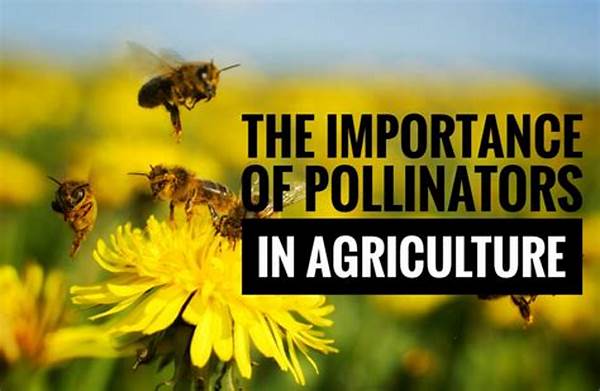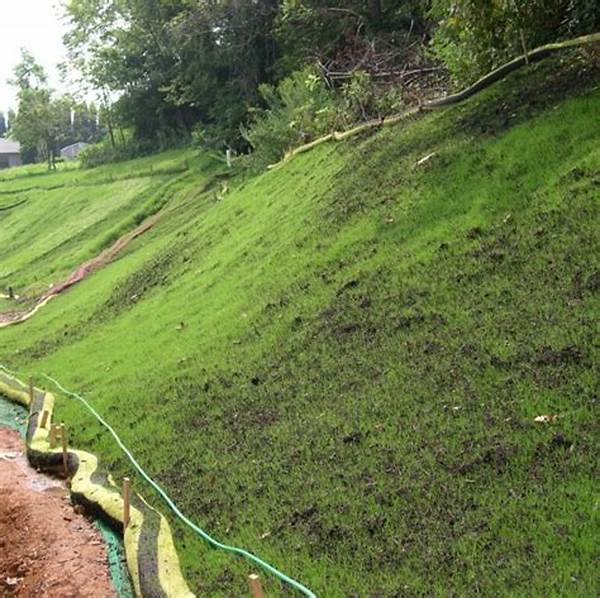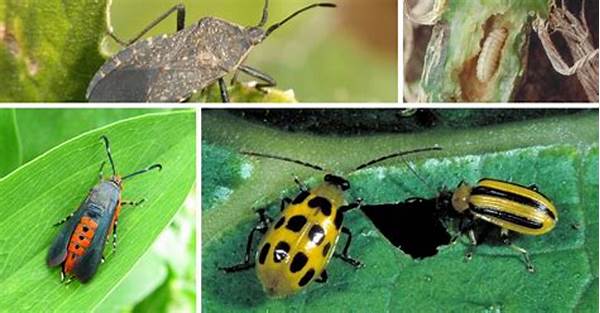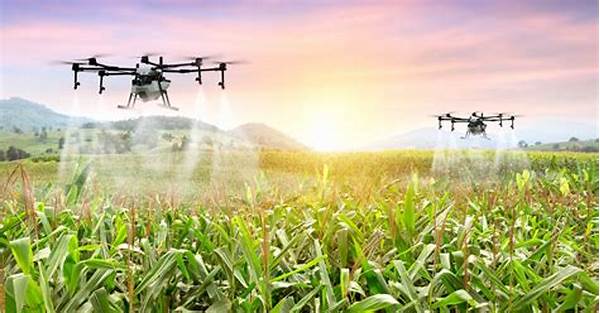In the universe of agriculture, pollinators are as critical as the seeds we sow and the soil we till. They are the silent architects of our ecosystems, ensuring the successful cultivation and yield of our crops. Yet, with the growing threats from human activities and environmental changes, the need for the conservation of pollinators in agriculture has never been more urgent. It’s not just about protecting bees and butterflies; it’s about safeguarding our food security, preserving biodiversity, and ensuring the health of our planet. By conserving these precious pollinators, we stake a claim on a future that is sustainable, bountiful, and harmonious.
Read Now : Sustainable Soil Enrichment Strategies
The Importance of Pollinators in Agricultural Ecosystems
Pollinators play an essential role in the success and sustainability of agricultural ecosystems. They are responsible for the reproduction of over 75% of the leading global crops, contributing directly to the food production that sustains billions of people around the world. Imagine a world without vibrant fruits, vegetables, and nuts—our nutrition would profoundly suffer. Moreover, pollinators significantly enhance the yield and quality of crop production, ensuring that farmers meet the market demands and consumers receive the nutrition they deserve. Therefore, the conservation of pollinators in agriculture is not a mere option but a necessity that requires immediate action and commitment from all stakeholders involved.
The fight for pollinator conservation is also a fight for economic stability in agriculture. Pollinators contribute an estimated $235 billion to $577 billion worth of global food supply annually. This astounding economic impact underscores the notion that losing pollinators due to neglect could impose severe financial burdens on farmers and economies worldwide. Thus, the conservation of pollinators in agriculture represents a sound economic strategy that benefits everyone, from farmers to consumers, and ultimately contributes to the stability and prosperity of our economies.
Finally, pollinators are vital for maintaining biodiversity within agricultural landscapes. The interdependence of flora and fauna creates a tapestry of life that is both resilient and self-sustaining. By focusing on the conservation of pollinators in agriculture, we also conserve biodiversity, ensuring that ecosystems remain robust and capable of adapting to changes. In the face of climate change and habitat destruction, fostering a biodiverse environment is more critical than ever. Pollinators are the bridge to a thriving, healthy world, and their conservation serves as the foundation for broader ecological resilience.
Strategies for Effective Pollinator Conservation in Agriculture
1. Implement Integrated Pest Management (IPM): Utilizing IPM reduces dependency on harmful pesticides, which in return protects pollinators. This is central to the conservation of pollinators in agriculture.
2. Develop Habitat-Friendly Practices: Introducing flowering plants and cover crops in fields provides necessary habitats, aiding significantly in the conservation of pollinators in agriculture.
3. Engage in Public Awareness Campaigns: Educating communities about the importance of pollinators fosters a collective responsibility and aligns efforts towards their preservation.
4. Support Research and Innovation: Investing in scientific research leads to better practices and knowledge towards the conservation of pollinators in agriculture.
5. Policy Development and Implementation: Strong governmental policies are crucial in enforcing standards that prioritize the conservation of pollinators in agriculture.
Challenges Facing Pollinator Conservation
Despite their indispensable role, pollinators face numerous challenges that threaten their populations. Pesticide use, habitat destruction, and climate change are at the forefront of these challenges. With each indiscriminate spray of chemicals, we edge closer to diminishing their numbers, simultaneously eroding the foundation of our food systems. The conservation of pollinators in agriculture thus becomes a complex task hindered by these multifaceted threats, requiring innovative solutions and unwavering commitment.
Addressing these challenges necessitates a coordinated global approach. Governments, farmers, researchers, and individuals must work together to ensure effective conservation of pollinators in agriculture. Legislative action is required to regulate pesticide use and protect habitats. Farmers can contribute by adopting sustainable agricultural practices, while researchers can provide data to guide these practices. The synergy of these efforts will help to create resilient and thriving pollinator populations, thereby securing the future of agriculture.
Measures to Support Pollinator Populations
Conservation of pollinators in agriculture requires a multifaceted approach, integrating ecological stewardship and sustainable practices. Promoting native plant growth and reducing monocultures can drastically improve habitat and food resources for pollinators. Furthermore, encouraging organic farming practices helps minimize the use of chemical pesticides, fostering a safer environment for these vital creatures. Creating pollinator-friendly policies that incentivize protective measures is another crucial step towards sustainable ecosystems.
Read Now : Organic Farming Pest Management Strategies
It is essential to support local initiatives that focus on the conservation of pollinators in agriculture. Community-led programs can foster grassroots involvement and promote education regarding pollinator significance. Investment in research and development can drive innovation, creating new methods to protect and strengthen pollinator populations. These cumulative efforts ensure a future where food systems are robust, resilient, and capable of withstanding environmental uncertainties.
Collaborative Efforts for a Resilient Future
A thriving agriculture system hinges on collective action aimed at preserving pollinator health. Strengthening partnerships between stakeholders in agriculture and environmental conservation can lead to significant advancements in the conservation of pollinators in agriculture. Collaborative efforts can lead to the creation of sustainable agricultural practices that benefit both the environment and economy. Farmers, scientists, policymakers, and consumers must come together to advocate for the wide-scale adoption of pollinator-friendly practices.
Governments have a critical role in legislating and enforcing regulations that support the conservation of pollinators in agriculture. Developing incentives for farmers who adopt sustainable practices will encourage more widespread use of pollinator-friendly techniques. Additionally, fostering public awareness campaigns can engage communities and inspire action at all levels, ensuring that pollinator conservation becomes a universally shared priority.
Community Engagement in Pollinator Conservation
Engaging communities is pivotal to the conservation of pollinators in agriculture. Grassroots movements can raise awareness and drive action on a local level, encouraging individuals to create pollinator-friendly spaces in their yards and neighborhoods. Schools can integrate pollinator conservation into their curricula, cultivating an understanding of ecological interconnectedness in future generations.
Local governments can support these initiatives by providing incentives for pollinator-friendly landscaping and offering resources for community pollinator gardens. By fostering a sense of shared responsibility and ecological custodianship, we can ensure that the conservation of pollinators becomes a community-wide effort. Engaging directly with the land and its guardians, we can initiate a groundswell of change that reverberates through our fields, farms, and beyond.
Ensuring Long-Term Success in Pollinator Conservation
Achieving lasting success in the conservation of pollinators in agriculture requires strategic planning and commitment from diverse sectors. By promoting interdisciplinary research, we can develop innovative solutions tailored to the unique challenges presented by different ecosystems. Collaborative platforms where scientists, farmers, and policymakers can share insights and solutions are essential to formulating effective conservation strategies.
Financial investment in pollinator conservation must also be prioritized. Public and private sectors should allocate funds specifically for research and programs that aim to bolster pollinator health. Moreover, creating financial models that illustrate the economic benefits of healthy pollinator populations can be persuasive in galvanizing broader support for these initiatives.
A Call to Action for the Future
The clarion call for the conservation of pollinators in agriculture is one that demands immediate attention and action. Each player, from local farmers to global leaders, holds the power to influence this pivotal change. Supporting sustainable practices, fostering biodiversity, and advocating for policies that protect pollinators are all steps toward a more resilient agricultural future.
Our actions today will determine the state of our ecosystems tomorrow. By committing to the conservation of pollinators in agriculture, we are investing in the security of our food systems, the health of our ecosystems, and the prosperity of future generations. Together, we can create a world where both people and pollinators coexist in harmony, ensuring a vibrant and sustainable future for all.



